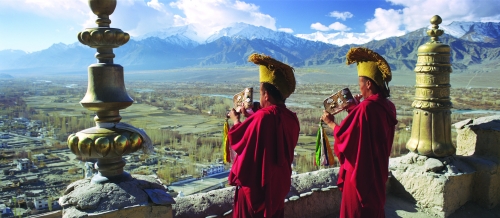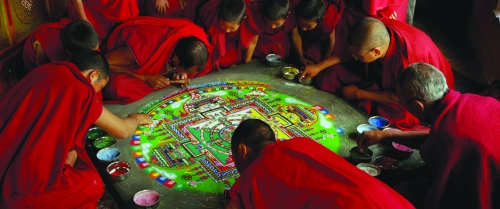Samsara
Directed by Ron Fricke
Produced by Mark Magidson
Released August 24, 2012
99 minutes
Samsara is a film without dialogue or narration, a series of wondrous and occasionally bewildering images set to a vibrant original score. Director Ron Fricke and producer Mark Magidson labored nearly five years to complete the film, traveling to 25 countries and editing the resulting footage together as a team. Their subjects range from a Buddhist monastery in Tibet to an auto-wreckage yard in California, from an ancient city in Burma to a modern prison in the Philippines.
The film’s title comes from the Sanskrit word for journey or flow, and the film feels like a journey through the incredible variety of earthly existence. In Buddhism, the term samsara can have negative connotations, referring to the great cycle of birth and death from which the Buddha himself was freed when he at last entered nirvana. But after watching the gorgeous scenes in Samsara, one hardly wants to leave.
It may be hard to imagine sitting through a 99-minute film without characters or a plot, but Samsara is surprisingly captivating. An early shot of an erupting volcano quickly casts the audience into a near trance, filling the theater with its deep red glow. The filmmakers have called their work a “guided meditation,” an apt description of such an unusual form of documentary. There is a relaxed quality to much of the filming, with the camera lingering so long that whole scenes can feel like stills. Even their human subjects are often shown staring into the camera, nearly unmoving. At times only the slight drifting of a cloud betrays that we are watching a motion picture.
 Yet other scenes teem with movement. Extended use of time-lapse photography (captured on a custom-built camera) allows us to watch stars literally fly across the night sky and trace traffic speeding through a teeming metropolis. A long shot of the Hajj in Mecca is especially powerful, as pilgrims circling the Kaaba become a virtual sea of humanity, as if carried by an invisible current.
Yet other scenes teem with movement. Extended use of time-lapse photography (captured on a custom-built camera) allows us to watch stars literally fly across the night sky and trace traffic speeding through a teeming metropolis. A long shot of the Hajj in Mecca is especially powerful, as pilgrims circling the Kaaba become a virtual sea of humanity, as if carried by an invisible current.
Some sequences are thematically linked. We move, for example, between the DMZ walls separating North and South Korea and the Western Wall in Jerusalem. The shifts can sometimes be disorienting, leaving us to work out for ourselves where we’ve landed. A subway in Tokyo suddenly becomes a subway in Sao Paulo, with only the writing on a few wall-hung advertisements betraying the 11,500 miles we have traveled.
While there is no overt political message to Samsara, the filmmakers often seem to contrast the beauty of the natural world and ancient traditions with the absurdities of industrial production and modern human life. After countless landscapes of breathtaking beauty, a Chinese worker is shown repeatedly adjusting a single screw on a seemingly endless assembly line of electronic components. Perhaps most horrifying are several scenes of factory farming. (The film may well leave a growing population of vegetarians in its wake.)
While there is no true narrative structure, there is something of an arc to the film. A Tibetan Buddhist sand painting painstakingly created by monks early on is finally destroyed in the final scenes. Haunting panoramas of the Himalayas also seen in the opening return again as the film comes to a close.
Ficke and Magidson previously collaborated on the 1992 film Baraka, and their new work is very much reminiscent of that earlier effort. (A few locations captured in Baraka even reappear here.) Both were photographed on 70mm film, but the material in Samsara was then transferred to a high-resolution digital format for editing. The resulting images are stunningly vivid, with rich color and extraordinary detail in every frame.

The editing itself can be as provocative as the images. Scenes of a factory producing highly realistic sex dolls in Japan, with plastic reproductions of idealized female forms in various stages of dismemberment, are followed by a scene of sex workers in Thailand, dancing provocatively for an unseen audience. After watching a funeral featuring a designer coffin in the shape of a pistol, we find ourselves in a gun factory in the Philippines, and then among rifle-toting villagers in a remote corner of Ethiopia.
The soundtrack, by composers Michael Stearns, Lisa Gerrard, and Marcello De Francisci, also deserves special attention. Alternately pensive and kinetic, the music guides us artfully through each scene. Macabre shots of the long aftermath of Hurricane Katrina—a car now wedged impossibly between two houses, the mud-soaked ruins of a dollar store—are set to an eerily soft orchestration, while the majesty of the Himalayas is accompanied by bright ceremonial horns. In many landscapes, the music is the only discernable sound, and it often sets the emotional tone for the incredible visual imagery.
There are a few false notes. A quick cut from the gruesome meat-packing plant in China to a Costco big-box store in America will strike some as too obvious a comment on contemporary consumerism, and feels somewhat out of place in a film that usually chooses to be more subtle. A perhaps overly long scene of performance art, involving a businessman smearing his face with clay, also felt jarring, a set piece that sits uncomfortably with the myriad stronger found images. But these slight missteps are rare exceptions among so many unexpected delights.
In the end, Samsara paints an inspiring portrait of life on Earth. It seems a small miracle that such a delicate and improbable film could survive in the cutthroat world of modern movie making. The bodhisattvas Fricke and Magidson deserve many thanks for holding up this magnificent mirror to the phenomenal world.